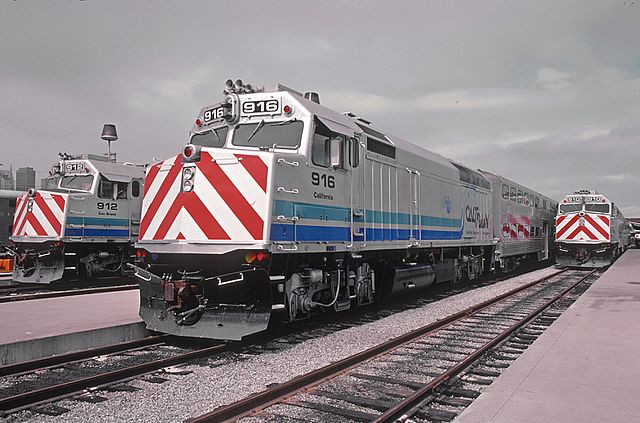The XpressWest high-speed rail project, to connect Nevada’s Las Vegas to California’s Victorville and beyond, has an anticipated winter 2020-’21 construction start date, with a ’23-’24 projected begin operations/service date. The line, some 180 miles long – 135 miles of which will be in the Golden State – has a $5 billion building-cost estimate. XpressWest is a private enterprise.
The California high-speed rail endeavor, on the other hand, at 520 miles in length linking San Francisco with Los Angeles and Anaheim, is a public property approved by a majority of state voters, way back in 2008. At that time, it had an estimated price tag of $33 billion, rising to a high of $98 billion in the 2010s before settling back to approximately $80 billion where it remains today.
People have been critical and skeptical, some even going so far as to opine that California is incapable of getting major infrastructure projects done anymore. They cite managerial or oversight irresponsibility, litigation, cost overruns, delays all as factors.
In his latest rebuke, meanwhile, Dan Walters, a political analyst at Calmatters.org, with what he refers to as the California bullet train “boondoggle,” cites Los Angeles Times reporter Ralph Vartabedian who suggested the state cut its losses and abandon it. Imagine what would have been the outcome had sentiment like that regarding completing the new eastern span of the San Francisco-Oakland Bay Bridge carried the day. What California and its citizens would have been left with is a crumbling and decrepit original eastern bridge span, perhaps repairable, perhaps not.
Cut the losses and walk away … pooh! To put it bluntly, not a good idea.
With some 100 miles of Calif. high-speed rail right-of-way cleared and with construction work and high-speed train-related infrastructure either in progress or already built at more than 30 locations up and down the San Joaquin Valley, walking away just doesn’t jibe in pragmatic terms and wouldn’t bode well presumably where construction of future in-state mega-projects are concerned.
Firstly, 4,000 good-paying contractor jobs would fall by the wayside just like that! Not to mention positions indirectly tied would, at the very minimum be negatively affected. Local economies would feel the pain, most assuredly.
Secondly, the infrastructure already built and in place would have been all for naught. Such completed projects include the State Route 180 trenching work, San Joaquin River viaduct, overpasses at Tuolumne, Clinton and Ashlan avenues, Ashlan-to-Clinton avenues’ coupled State Route 99 relocation work, northwest Fresno pergola building plus all of the affiliated below- and above-ground utility relocation, soil testing and all preparatory effort would have all been in vain. And, this, just in the city of Fresno. Think about the time involved or dedicated to those alone.

Cutting losses and ties, no – that’s not gonna fly. Complete the work, do it right, move ahead and don’t look back.
Remember the early engineers who built the aqueducts, viaducts, highways, byways, railways and more? What if they had thrown in the towel and just walked away? Where would we have been then and where would we be now?
On the high-speed rail building front California cannot afford to not finish what it started. Shameful, inexcusable it would be to not do that.
Image above: Roger Puta
This post was last revised on Aug. 20, 2020 @ 7:18 a.m. Pacific Daylight Time.
– Alan Kandel

Why the photo of the low speed diesel locomotives?
That aside, almost all the high speed rail projects around the world have have cost more that anticipated including the very first one in Japan. But when they finished them they were hugely popular and more were built as a consequence.
We need to finish the Merced to Bakersfield section and start work on the links to San Francisco and Los Angeles.
Choosing the photo of the Caltrain locomotives corresponded to the paragraph with the “conventional train travel” reference. There are no American high-speed rail systems in operation yet, unfortunately.
As to your second point, that’s a good one. That’s one of the points I have tried to stress on the Air Quality Matters blog and that is that once high-speed rail service is offered between Bakersfield and Merced and riders get to experience first-hand what high-speed train travel is all about, that such will drive additional ridership and hopefully further expansion of California’s high-speed rail system.
As to the message in your last paragraph, I could not agree with you more!
“Sunk cost fallacy” – just because money has been spent on a project should not influence the decision on whether or not to continue with the project. That money is gone, whether or not you move ahead. The appropriate question is, based on an updated cost-benefit analysis, is the project worth continuing?
Also, the argument that a project creates jobs is irrelevant. The cost of labor is one of the costs to be factored in to the cost-benefit analysis. If the project is not viable financially, then it shouldn’t continue just because it creates jobs.
You ask if “the project is worth continuing.” I say it is most definitely.
In the post “U.S. high-speed rail: Good for the environment, good for the pocketbook” https://alankandel.scienceblog.com/2015/01/15/u-s-high-speed-rail-good-for-the-environment-good-for-the-pocketbook/ the analysis I have done, in my opinion, lends credence.
Internationally, there are two high-speed rail systems that are profitable: one in Japan and the second in Spain. I don’t know this to be true of any highway, but one somewhere may be.